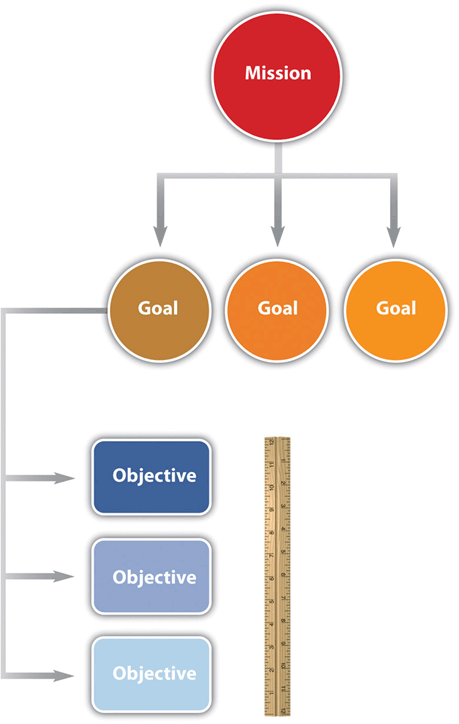7.1 Project Selection
Visit Audio Recordings for the audio version of this section.
LEARNING OBJECTIVES
- Describe the difference between an organization’s mission, goals, and objectives.
- Describe how the missions are different depending on the type of organization.
- Define economic terms used for choosing projects.
- Describe the influences of funding, timing, and unofficial considerations on project selection.
- Define a project champion and his or her role.
Projects are chosen for a variety of reasons and not all of them are apparent. The project manager must understand why a project was selected over other choices so that he or she can align the team toward justifying the choice that has been made by senior management.

Mission of the Organization
The mission of an organization is a statement of why it exists. For example, a police department might have its mission stated on the door of each patrol car—to protect and serve. A well-written mission statement is short and has the following sections:
- Purpose of the organization
- Primary stakeholders
- Responsibility of the organization toward the stakeholders
- Products or services offered
BYU IP&T Department Mission Statement
The objective of the Department of Instructional Psychology and Technology is to enhance learning by improving instruction and teaching. In partnership with others, the department will (1) search for knowledge that improves instruction, (2) apply knowledge and technology to solve instructional problems, and (3) empower students with knowledge and skills in instructional development, research, evaluation, and measurement.1
Organizations can be categorized as profit, not for profit, and government. A business that is created to make a profit for its owners and stockholders must consider the cost of each project and how much profit it is likely to generate. The mission statement of a not-for-profit organization, like a charity, would emphasize the service it provides. A not-for-profit organization must control its costs so that it does not exceed its funding, and it is always seeking funding and is in competition with other not-for-profit organizations for funding from the same sources. A government agency, like a police department, is similar to a not-for-profit organization but its sources of funding are usually taxes and fees. Its mission would include its responsibilities to the citizens it represents. Government organizations compete for funding from higher levels of government. Projects are more likely to be funded if the proposal for the project is closely aligned with the mission of the organization. The project manager must be aware of that mission while building a team and aligning it behind the purpose of the project.
Goals and Objectives
Senior administrators of the organization decide on how to achieve the mission of the organization by choosing goals. For example, the director of a not-for-profit preschool that provides low-cost education for children of poor, single parents might set a goal of improving its reputation for quality. A goal is an end toward which effort is directed. The director meets with her staff and they consider several ways of achieving that goal. They decide to seek certification by a nationally known group that evaluates the quality of preschool programs. Obtaining this certification is an objective.
In this text, we distinguish between the terms goals and objectives. An objective must have a measurable outcome. In this example, it is easy to measure whether or not the organization receives the certification, which is the distinguishing characteristic of an objective. The use of these terms is not standardized across the industry or in business, but we will be consistent within this text. To determine whether a statement is a goal or an objective, simply ask if there is a measurable outcome. Seeking the certification is an objective that can be met by treating it as a project that has a measurable outcome and a limited time frame.
Figure 7.1 Relationships between Mission, Goals, and Objectives

Economic Selection Criteria
If an organization’s mission is to make money, it will try to maximize the profits of the company by increasing the money coming in or decreasing the money going out. The movement of the project’s money is called cash flow. Money coming in is positive cash flow, and money going out is negative. The company can maximize profits by improving its operational efficiency or by executing projects. The company must raise money to fund projects. Companies can raise money in three ways:
- Borrow it (government organizations, such as cities and schools, can sell bonds, which is a form of borrowing).
- Fund the project from existing earnings.
- Sell additional stock or ownership shares in the company.
If a company borrows money, it must pay back the amount it borrowed plus additional interest. The interest is a percentage of the amount of the loan that has not been repaid. The repayment of the loan and interest is usually paid quarterly or annually. To qualify for selection, a project that is intended to make or save money must be able to do the following:
- Repay loans if money must be borrowed to fund the project
- Increase future earnings for shareholders
- Make the company stock more valuable
When senior managers at a for-profit company decide which projects to fund, they must consider these economic issues.
Simple Payback
To help managers choose between projects, they can use an unsophisticated measurement called simple payback. If the purpose of the project is to improve cash flow—make it more positive or less negative—the improved positive cash flow each year is applied to the original cost (negative cash flow) of the project to determine how many years it would take to pay back the original cost. It is assumed that after that date, the improved cash flow could be used for other purposes or paid out to owners. For example, if the company borrows $100,000 to fund the project and the project increases cash flow by $20,000 a year, the simple payback would be five years, as shown in Figure 7.2.
Figure 7.2 Simple Payback

The cash flow from each year is summed up in the cumulative cash flow row. When the cumulative cash flow becomes zero or positive, it means that the original cost has been paid back by the increased income or savings created by the investment.
Companies can use simple payback to establish a cutoff for project consideration. For example, management could declare that no projects will be considered that have a payback of more than three years. For projects that meet this criterion, projects with shorter simple payback periods would have an advantage in the selection process. Not-for-profit or government organizations are likely to approve projects with longer simple payback periods because they are not compared to other not-for-profit or government agencies based on their profitability.
Internal Rate of Return
Companies whose mission is to make a profit are usually trying to make more profit than their competitors. Simply paying back the loan is not sufficient. If the project involves buying and installing equipment to make a profit, executives can use another method called internal rate of return (IRR). The IRR is like an internal interest rate that can be used to compare the profitability of competing projects. To calculate an IRR, the company considers the cash flow each year for the expected life of the product of the project. It assumes that some of the annual cash flows will be negative and that they can vary from year to year due to other factors, such as lost production during changeover, periodic maintenance, and sale of used equipment. For example, a company decides to upgrade a manufacturing line with new equipment based on new technology. They know that the initial cash flow—shown in year zero—will be negative due to the expense of the conversion. They know that the new equipment has an expected life of six years before newer technologies make it out of date, at which time they can sell it for a certain salvage value. The inputs to the IRR calculation are the net cash flow for each year where at least one of them is negative and at least one of them is positive. The result is a percentage that indicates how well this project performs as an investment. (See Figure 7.3.)
Figure 7.3 The internal rate of return measures the profitability of an investment.

The life of the equipment is part of the IRR calculation. If a project manager knows that senior management intends to sell the equipment in six years, team members can be made aware of that decision if it affects their choices.
Other Selection Criteria
Besides making money, there are many other reasons for a project to be selected, including the following:
- Keeping up with competitors
- Meeting legal requirements, such as safety or environmental protection
- Improving the organization’s public image
The timing of the project can be very important. A project might be selected at a particular time of year for some of the following reasons:
- Accumulating a year-end budget surplus
- Increasing executive bonus for the year or quarter
- Funding or certification review deadline
If the project manager must make changes to the schedule at some point in the project that could affect its completion date, it is valuable to know if the project was selected because of timing.
Project Champions and Opponents
In addition to knowing why a project was selected, it is valuable to know which senior executives supported or opposed the selection of the project and if the project manager’s supervisor was in favour of it or not. Because most project teams consist of people who do not report to the project manager but who report to other unit managers, they might not be available when you need them if their boss thinks other projects are more important. If a particular executive proposed the project and actively advocated for its approval, that person could be a source of support if the project runs into trouble and needs additional resources. A project champion, sometimes called an executive sponsor, is an influential person who is willing to use his or her influence to help the project succeed.
To identify the advocates and opponents of the project, you can read public documents (if available), such as the minutes of the meeting at which the project was approved. Next, the project manager can use his or her unofficial network of trusted colleagues to get their opinions. Those discussions should be informal and off the record. Those opinions might be inaccurate, but it is valuable to know what misunderstandings exist about a project. If executives in an organization are assigned as project sponsors, the project champion might be a different person.
Project Champions Support Employee Performance Training
A large organization hired an instructional design team to improve employee performance. The project took over a year to complete and faced some setbacks due to resistance from middle management. During the course of the project, some department managers were frustrated with the time needed for the project team’s assessments, interviews, and test implementations, which interrupted the normal course of business. Some of the project team’s findings also indicated a need for specialized training, which put a greater burden on individual departments and the department managers balked at taking on this additional workload.
However, due to the organization director’s priority of performance improvement, the project team had the support and authority to continue. If upper management did not reinforce the efforts of the project team, the department managers would have greatly inhibited the progress of the project. Ultimately, the project was a success and the department managers realized that the temporary upset to the status quo yielded exponential benefits to the organization as a whole.
KEY TAKEAWAYS
- A mission statement declares the purpose of the organization and identifies the primary stakeholders, the products or services offered, and the responsibility toward the stakeholders. Goals are statements of direction for the organization, and objectives are activities that achieve those goals with measurable outcomes.
- Profit-making organizations exist to make profits for their owners while in competition with other companies. Not-for-profit organizations are directed at providing a service to a particular group. A government agency is similar to a not-for-profit organization, but its sources of funding are usually taxes, fees, and funding from a higher level of government, and it has a responsibility to the citizens it represents.
- Two economic tools for evaluating and comparing projects are simple payback and internal rate of return. Simple payback is a calculation of the year when the cumulative income or savings due to spending money on a project will meet or exceed the original cost of the project. Internal rate of return is a calculation of the average percentage of increased cash flow over the life of the project’s product.
- Project selection depends on the availability of funds, which depends on the way each type of organization receives money for projects. Funds might be available at certain times and projects are selected that can take advantage of that opportunity. Projects might be initiated for reasons that are not stated, and investigating the source of funding and likely motivation of project champions can provide better understanding of the project’s chances for success.
- A project champion is an influential person who is willing to use his or her influence to help the project succeed. It is useful to know why the project champion wants the project to succeed and to be sure to accomplish that goal even if it is not stated.
[1] http://graduatestudies.byu.edu/node/2335
An end toward which effort is directed.
A measurable outcome.
Movement of the project's money.
A percentage of the amount of the loan that has not been repaid.
if the purpose of the project is to improve cash flow—make it more positive or less negative—the improved positive cash flow each year is applied to the original cost (negative cash flow) of the project to determine how many years it would take to pay back the original cost.
A method used if the project involves buying and installing equipment to make a profit.
The project sponsor is outside the day-to-day operations of the project and has the organizational authority to provide resources and overcome barriers for the project.

